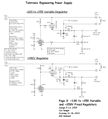Engineering Power Supply
-
-
-
-150V and +100V regulator schematic
-
+100V to +350V variable regulator and +350V fixed regulator schematic
-
-50V to +100V variable regulator and +225V fixed regulator schematic
-
Transformer, fan, rectifiers, and filter capacitor schematic
This information is being put out on the web to help others understand how the Tektronix Engineering Power Supply operates. If you find this in error, please take the time to edit the information.
Question: On the bottom row across the middle, on the red binding posts, these are ALL regulated supplies EXCEPT for the -50 to +100 and the +100 to +350 that are connected to the two black knobs just below the meters....................CORRECT?
Answer: 1- Correct. Technically the adjustable supplies are also regulated, by definition. In order to get the -50 to +100 range, a shunt must be placed between the two black posts where it says (- load). This causes the -50 to +100 to refer to a negative level instead of ground.
Question: How does one use the first two rows of black binding posts?
Answer: 2- The current level listed above the lower black post is the maximum current that may be drawn from the RED post without any shunt resistor. The shunt resistor would go between the two black posts. The upper black post is the raw high voltage to each regulator circuit. The lower is the output of the regulator. The shunt resistor is calculated to drop the voltage from input to output at the current level required above the rating. Example: look at column to the right that has +475 over 140 mA over +350. If you draw 150 mA, your shunt is (475-350)/.01 or 12.5 kΩ. It's wattage would be (.01 x .01) x 12500 or .25 watts. Very important! Most of the time your shunts will need to be some serious high wattage big resistors. Always calculate it!
Question: How are the -150/SHUNT to ground binding posts used?
Answer: 3- The -150/Shunt is like the others just arranged differently. The shunt for -150 just goes to ground because the supply is basically "upside down".
Answer: 4- The red posts having the regulated outputs always refer to ground and should handle currents up to the limits printed on the panel at each corresponding black post. If you don't use shunts and stay within those limits, it's very straightforward. Without the (-load) shunt the -50 to +100 supply is a 0 to +150 supply.
The most important thing to remember is that the power transformer has limits for current that are not way above the regulators. So DON'T get the idea you can shunt your way to 300 mA at 500 V. You can find those numbers by looking up the Tek part number on the transformer you have.
For fixed supplies, shunts are calculated as (Vunreg-Vreg)/(Itotal-Imax)=Shunt. Easy enough. Imax being the max unshunted current printed on the front panel. Remember to calculate dissipation for the shunt. It can get high! For 100-350 V supply it's more complicated. At each of these voltages, the max current without a shunt is:
- 100 V, 32 mA
- 150 V, 37 mA
- 200 V, 45 mA
- 250 V, 55 mA
- 300 V, 70 mA
- 350 V, 100 mA
This is because as the voltage out goes up, the pass tube has less voltage across it and can therefore handle more current within plate dissipation ratings. Shunts are calculated against +475 unregulated, using the formula above, where Imax depends on the voltage level you dial in. A 1 kΩ shunt at 100 V out puts you at 382 mA! At 300 V out, you're down to 225 mA with that same 1 kΩ. At 300 V, you're dropping 125 V through 1000 Ω, drawing 125 mA plus the 100 mA the reg is good for at 300 V ...
The -50 to +100 regulator is a drag. If you don't put the (-load) in, it's a 0 to 150 variable. If you want -50 to +100 put the (-load) shunt in. It is (Itotal)/-100 = Rshunt where current flows backwards (the -100). You can still dial it variable and these are the pass tube limits:
- -50 V / 55 mA (But 45 goes through (-load) so you have 100 mA)
- 0 V / 70 mA (this would only actually draw current if referenced to a nonzero point)
- +50 V / 100 mA
- +100 V / 100 mA
The pass tube limit is never over 100 mA.
If this supply doesn't need to go negative you can shunt it like the others, calculated where the unreg is +175. i.e. at 100 V out with a 1 kΩ shunt resistor gets you 75 mA plus the 100 mA pass tube capacity.
You could use both shunts together to get higher currents at negative voltages, but you'll need to do some nodal analysis.





